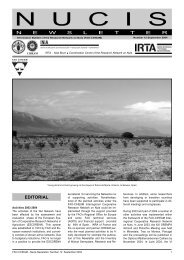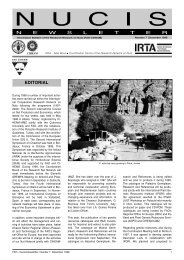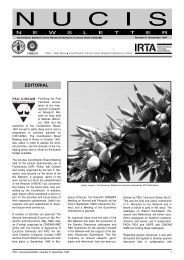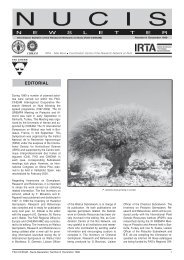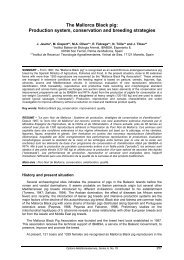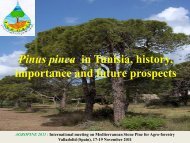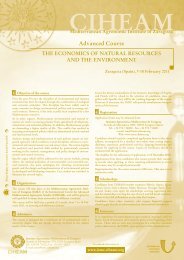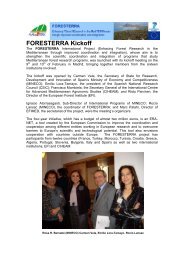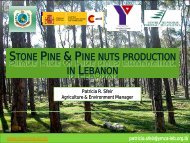NUCIS number 10. December 2001. 48 pages (full ... - IAMZ - ciheam
NUCIS number 10. December 2001. 48 pages (full ... - IAMZ - ciheam
NUCIS number 10. December 2001. 48 pages (full ... - IAMZ - ciheam
Create successful ePaper yourself
Turn your PDF publications into a flip-book with our unique Google optimized e-Paper software.
RNase polyacrylamide gel<br />
Agarose PCR gel<br />
leading to year to year fluctuations. Nevertheless,<br />
field-testing is required to verify<br />
the best crossing combinations to<br />
achieve self-compatible progenies or to<br />
identify production differences among related<br />
S-genotypes. To improve the efficiency<br />
of the field methods, autogamy levels<br />
for the same cultivars should be recorded<br />
over several years. Similarly, pollen-growth<br />
studies in the laboratory suffer<br />
from moisture stress in flowers removed<br />
from the tree, and consequently growth<br />
rates may be adversely affected. Pollen<br />
tube growth in laboratory should be tested<br />
at least for two years to be confident<br />
on results. Only by field assays it is impossible<br />
to predict the best crosses to<br />
achieve 100% self-compatible progenies<br />
or to identify genetic differences between<br />
related individuals.<br />
Table 1 summarises different aspects of<br />
the biological and molecular approaches<br />
for the assessment of self-incompatibility<br />
in almond. Applicability for routine work,<br />
usefulness, preciseness, rapidity and cost<br />
of the different methods has been rated.<br />
RNases analysis provides important advantages:<br />
• It tests the enzyme directly associated<br />
with self-incompatibility.<br />
• Since all self-incompatible alleles are visible<br />
after gel staining, it allows differentiation<br />
between self-compatible and selfincompatible<br />
cultivars in segregation progenies<br />
as well as the detection of new S-<br />
alleles.<br />
• It can provide S-genotype information to<br />
Table 1. Ratings of biological and molecular approaches for the assessment<br />
of self-incompatibility in almond.<br />
Aspects rated 1 Biological methods Molecular methods<br />
Field crosses Microscopy S-RNases PCR<br />
Availability of facilities ++++ +++ +++ ++<br />
Repetitiveness ++ ++ +++ ++++<br />
Interpretation of results +++ ++ +++ ++++<br />
Ease of routine application ++ ++ ++++ ++++<br />
Speed in obtaining results + ++ ++++ ++++<br />
Initial investments +++ +++ ++ +<br />
Cost of development ++++ +++ ++ +<br />
Cost per sample ++++ ++++ ++ +<br />
1<br />
Rates given as a scale between ++++ (good) and + (bad).<br />
assist early field selection of parents to<br />
obtain 100% self-compatible offspring<br />
(Batlle et al., 1997; López et al., 2001;<br />
Mnejja et al., 2002).<br />
• Testing of only 5-10 pistils is required<br />
(Batlle et al., 1999).<br />
• It allows modification of electrophoresis<br />
conditions in order to improve discrimination<br />
between alleles.<br />
• It presents a high reproducibility.<br />
• It involves moderate costs for equipment<br />
and consumables and so less initial<br />
investment than PCR and other molecular<br />
techniques.<br />
Limitations of the RNases approach include:<br />
• Pistils are required during the blooming<br />
period, thus flowering trees of at least 2-3<br />
years old are needed.<br />
• Protocol development is arduous and<br />
specific only for RNases assessment.<br />
• Many factors influence protein migration<br />
during electrophoresis.<br />
• The electrophoresis process is tedious<br />
and time-consuming, particularly for vertical<br />
polyacrilamide gels, which are very<br />
thin (0.75-1 mm), and posterior staining.<br />
• Difficult zymograms interpretation.<br />
The main advantages provided by PCR<br />
approaches include:<br />
• It allows the use of vegetative tissues,<br />
which are available since first sprout, therefore<br />
it is not necessary to wait for the<br />
blooming period. Seedlings can be grown<br />
easily in greenhouses to provide leaves,<br />
selecting only the self-compatible ones to<br />
plant in the field.<br />
• Only 0.1g of leaf tissue is necessary.<br />
• Easy preparation and management of<br />
horizontal agarose gels, and good applicability<br />
for routine work.<br />
10 FAO-CIHEAM - Nucis-Newsletter, Number 10 <strong>December</strong> 2001



